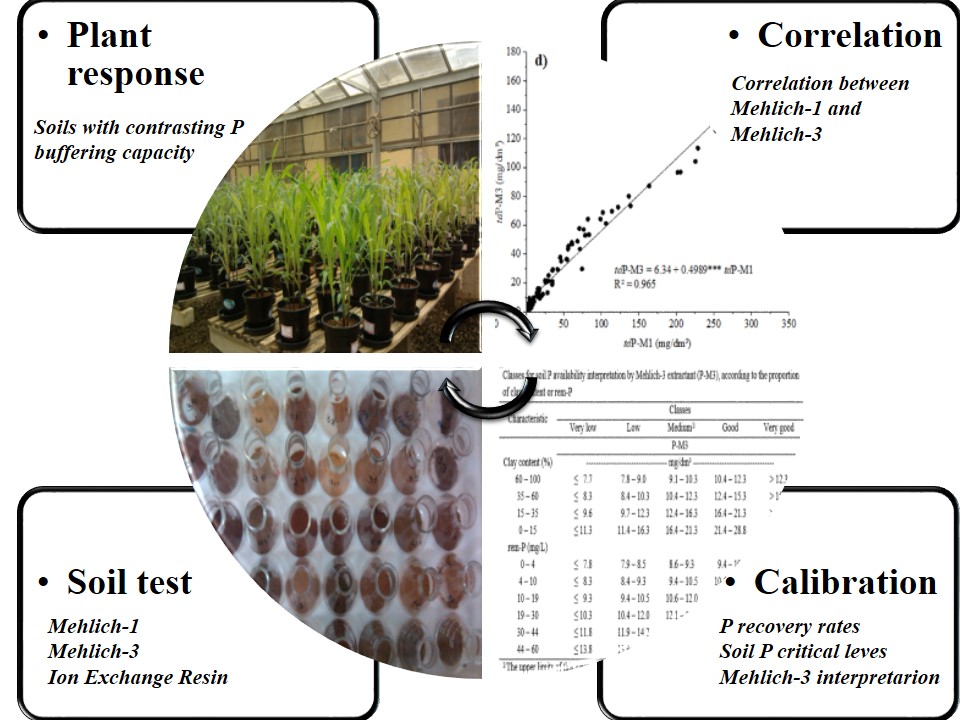Interpretation of soil phosphorus availability by Mehlich-3 in soils with contrasting phosphorus buffering capacity
02/Apr/2020
ABSTRACT Increasingly rational use of phosphate fertilizers by agriculture is important, especially in Brazil, due to its importance for global food security and its high dependence on phosphate fertilizers for crop production. Thus, correlation and calibration researches with soil available phosphorus (P) extractants to improve the recommendation and the use of P are extremely important. Our objectives were (i) to determine soil P recovery rates and critical levels by the extractants Mehlich-1 (M1), Mehlich-3 (M3), and Ion Exchange Resin (RTI); […]
Modeling in the Adjustment of Fertilization Recommendation through Leaf Analysis in Fertigated ‘Prata’ Banana
26/Nov/2018
ABSTRACT: In banana cultivation, fertilization recommendations are almost exclusively based on soil chemical analysis, without considering leaf analysis and expected yield, which can help in the adjustment of fertilization programs. The aim of this study was to develop a method to recommend macronutrient fertilization rates which integrates data on leaf analysis, soil chemical analysis, and yield. Yield, soil chemical analysis, and leaf analysis data of fertigated plantations of ‘Prata’ banana were obtained for the first and second halves of the […]
Potassium Fertilization for Long Term No-Till Crop Rotation in the Central-Southern Region of Paraná, Brazil
13/Sep/2016
ABSTRACT Fertilization programs for annual crops in the state of Paraná, southern Brazil, are based on studies that focused on conventional tillage and were established more than 30 years ago. The primary purpose of this study was to assess potassium (K) fertilization on long-term (>30 years) no-tillage soybean, corn, wheat, and barley crops grown in rotation on Oxisols in the central-southern region of Paraná. A total of 47 experiments were carried out from 2008 to 2013, three of which addressed […]
Phosphorus Fertilization for High Yield of Soybean, Maize, and Winter Cereal Crops in Rotation in Oxisols under Long-Term no-Till in the South Central Region of Parana, Brazil
01/May/2015
Although the State of Parana, Brazil, has adopted crop rotation and no-till (NT) systems, fertilizer application is still based on recommendations developed more than 30 years ago for monocropping under conventional tillage because fertilizer recommendations developed specifically for crop rotation under NT are lacking. The objective of our study was to consolidate P calibration and evaluate crop responses to P fertilization so as to propose a system of technical recommendations for P fertilization for soybean, maize, wheat, and barley grown […]
Nutrition standards for flooded rice by the methods compositional nutrient diagnosis and mathematical chance
01/Feb/2013
For rice, few studies use foliar analysis methods developed for local conditions of climate, soil or cultivars. The purpose of this study was to evaluate the methods of Compositional Nutrient Diagnosis and of Mathematical Chance to define nutritional standards for rice fields in Rio Grande do Sul state, Brazil. Data of 356 irrigated rice fields for grain yield and foliar contents (N, P, K, Ca, Mg, S, B, Cu, Fe, Mn, Zn, and Mo) were used to calculate the sufficiency […]
Potting mix and phosphate fertilization for production of rooted Cocoa cuttings
01/Feb/2011
The effect of potting mix and phosphate fertilization on the production of rooted cocoa tree cuttings was evaluated and recommended rates and critical foliar P levels were determined based on a factorial 5 x 5 + 1 experiment: five potting medium (coconut fiber CF and Plantmax® mix), five P rates at planting (0 to 800 mg dm-3) and an additional P treatment (applied on the 30th day). Each plot contained 27 cuttings, of which 12 rooted cuttings were evaluated. From […]
Effectiveness of fused magnesium potassium phosphate for marandu grass
01/Dec/2009
The current high price of KCl and great dependence on importation to satisfy the Brazilian demand indicate the need for studies that evaluate the efficiency of other K sources, particularly those based on domestic raw material. For this purpose, a greenhouse experiment was conducted with samples of a sandy clay loam Typic Haplustox, in a completely randomized 4 x 3 x 2 factorial design: four K rates (0, 60, 120, and 180 mg kg-1), three sources (potassium chloride (KCl), fused […]
Forms and doses of urea to fertilize clonal cocoa tree cuttings cultivated in substrate
01/Dec/2008
Nitrogen is the mineral nutrient required most by plants. There are, however, no studies on N fertilization calibration for rooted cocoa tree cutting production on substrate and frequent irrigation. The objective of this study was to compare the efficiency of urea fertilization on substrate and leaves for rooted cocoa tree cutting and to define N recommendable doses and foliar critical N level. The experiment was set up in a rooted cutting breeding nursery of the Cocoa Biofactory Institute, in Ilheus, […]
Application of zinc doses via soil to irrigated banana “Prata Anã” (AAB) in northern Minas Gerais, Brazil
01/Dec/2007
A field experiment was conducted in Nova Porteirinha, MG, Brazil, in a dystrophic Red Yellow Latossol, to detect the response of the banana tree ‘Prata Anã’ to Zn doses through soil and critical Zn levels in soil and leaves. Four Zn doses were applied, corresponding to 0, 10, 20 and 40 kg ha-1 year-1 , using zinc sulfate as source. The treatments were arranged in a randomized block design, with three repetitions per block, totaling 36 experimental plots. The following traits were evaluated: […]
Relationships between soil class and nutritional status of coffee plantations
01/Apr/2005
Farm planning requires an assessment of the soil class. Research suggest that the Diagnosis and Recommendation Integrated System (DRIS) has the capacity to evaluate the nutritional status of coffee plantations, regardless of environmental conditions. Additionally, the use of DRIS could reduce the costs for farm planning. This study evaluated the relationship between the soil class and nutritional status of coffee plants (Coffea canephora Pierre) using the Critical Level (CL) and DRIS methods, based on two multivariate statistical methods (discriminant and […]

